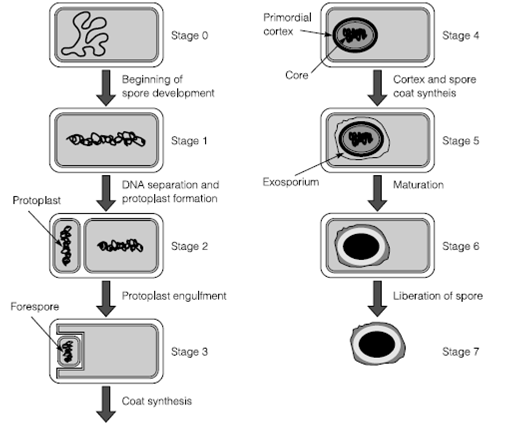Sporulation
Formation of endospores is a survival mechanism practiced through Gram-positive Bacterial genera, the best studied of that is Bacillus subtilis. It can be regarded as a specialized case of cell division with some of the mechanisms being same and performed through protein orthologs example for the sporulation protein SpoIIIE is very similar to FtsK. The spore and vegetative cell have very different properties outlined in the Table 1.
The procedure of spore formation can be divided into seven stages in Figure:
1.Starting of spore development. DNA moves to the central axis of the cell and becomes tightly coiled.

Figure . Bacillus subtilis sporulation.
2.DNA protoplast and separation formation. One complete chromosome becomes enclosed through the cell membrane and a protoplast is formed.
3.Protoplast engulfment. The mother cell engulfs the protoplast to make a forespore. The chromosome of what will become the spore is now surrounded through two membranes.
4.Coat synthesis. Wall material is deposited among the membranes and a primordial cortex forms around them. The material outside the cortex becomes increasingly dehydrated.
5.Spore coat synthesis and Cortex. Incorporation of calcium and dipicolinic acid.
6.Maturation. The spore becomes increasingly resistant to heat chemicals and radiation. The cortical layers become distinct.
7.Liberation of spore. The mother cell undergoes autolysis.
More than 50 genes and their products are specifically involved in sporulation all coordinated both temporally and spatially over about 6–7 hours. The reverse of the process first activation and then germination takes only minutes.